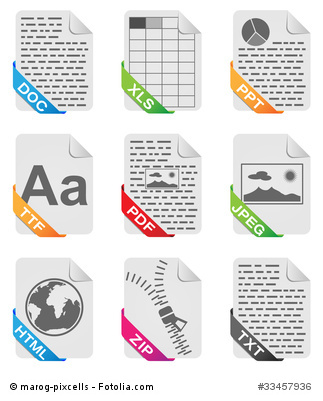Overview of the most important file and graphic formats
Text formats and their endings:
Docx: Microsoft Word documents (word processing) – Docx is the format of the latest version of MS Word. A docx file can contain text, images and graphics. Older Word versions may not be able to read the format..
TXT: Text file saved with the Microsoft Editor. TXT are plain text files. TXT files can be opened and displayed by the editor, by all word processing programs or with the browser.
RTF: Rich Text Format, Open Text Document Format – This document format can contain text, formatting instructions, text formatting, or images. Similar to the editor, Windows Wordpad can be used to create an RTF document that can be opened with text editing programs.
XLS: MS Excel documents (spreadsheet) – Microsoft Excel tables are saved in XLS format. In the meantime, the XLSX format already exists. An xls file exists as table values and formatting instructions and macros.
PPT: MS PowerPoint documents (slide presentation) – Microsoft PowerPoint presentations are saved in ppt format. This is an editable presentation. The most recent extension is now pptx. PPT documents contain text, lists, images, videos, music, Excel tables and much more. The individual elements can be faded in and faded out or assigned effects.
ODT: Open Office Text Document – An OpenOffice.org Writer document is a text document created with Open Office. Like Word files, ODT files can contain text, formatting, images, graphics or tables.
Graphic and image formats:
BMP: Windows Bitmap (image file) – A Microsoft Windows Bitmap image is saved as bmp and is considered a simple format for graphic data. These files are relatively large and not well suited for data exchange over the Internet.
JPEG: Joint Photographic Experts Group (image file) – Important and frequently used graphic format – Application area especially for websites, due to the small file size due to lossy compression – It is usually not used for printing, but for viewing on the monitor. So it can also be used to save compressed images.GIF: Graphics Interchange Format – An important graphics format that supports animation. Funny, animated GIFs can be found as collections on the Internet and enjoy great popularity throughout. GIFs can be compressed lossless and small file sizes are possible, which also results in low image quality. So the field of application is rather animations on websites.
PSD: Adobe Photoshop: Image processing format (Photoshop graphics format) – Adobe Photoshop documents are saved as PSD. The PSD format is a lossless graphics format that stores not only image data but also information about layers, masks, paths and more. PSD is mainly used for data exchange between graphic artists and designers. When opening psd files it can happen that some data cannot be read with older Photoshop versions.
PDN: Image file created with Paint.NET.
PNG: Portable Network Graphics (image file) – Frequently used image format that has the advantage that lossless compression is possible with relatively small file sizes. This is what makes it so valuable especially as web graphics and infographics – PNG is considered the best combination of the advantages of GIF and JPEG.
TIFF: Tagged Interchange File Format: Universal pixel image format – Important file format for graphics that can be compressed lossless. This results in very good quality, but a relatively large file size – Application area is above all where high-resolution printing is required.
—
PDF: Portable Document Format: True to format document format from Adobe – Portable document format from Adobe. The PDF is ideally suited for exchanging documents. It is regarded as the most used document format on the Internet and is often used for data exchange or for archiving data. PDFs contain text, images, graphics and more. The advantage is the platform independence and that a PDF always remains true to the original. The Adobe Acrobat Reader is the standard display program for the PDF format.
Almost all of the listed file formats can be easily converted into PDF format by webPDF and then further processed as PDF. The functionalities can be easily tested in the online demo of the webPDF portal.

